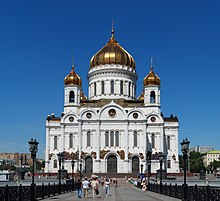Church of Christ the Savior
| Cathedral of Christ the Saviour Храм Христа Спасителя Khram Khrista Spasitelya |
|
|---|---|

The new Cathedral of Christ the Saviour as viewed from the bridge over the Moscow River
|
|
| Basic information | |
| Location | Moscow |
| Geographic coordinates | 55°44′40″N 37°36′20″E / 55.74444°N 37.60556°ECoordinates: 55°44′40″N 37°36′20″E / 55.74444°N 37.60556°E |
| Affiliation | Russian Orthodox |
| Year consecrated | 19 August 2000 |
| Website | xxc.ru |
| Architectural style | Russian Revival |
| Specifications | |
| Length | 79 m (NS-WE interior) 105 m (NS-WE stairs) |
| Interior area | 4,900 m² (interior) 6,800 m² (ext.-stairs) |
| Height (max) | 103.4 m (top cross) |
| Dome dia. (outer) | 29.8 m |
The Cathedral of Christ the Saviour (Russian: Храм Христа Спасителя, Khram Khrista Spasitelya) is a Russian Orthodox cathedral in Moscow, Russia, on the northern bank of the Moskva River, a few hundred metres southwest of the Kremlin. With an overall height of 103 metres (338 ft), it is the tallest Orthodox Christian church in the world.
The current church is the second to stand on this site. The original church, built during the 19th century, took more than 40 years to build, and was the scene of the 1882 world premiere of the 1812 Overture composed by Tchaikovsky. It was destroyed in 1931 on the order of Soviet leader Joseph Stalin. The demolition was supposed to make way for a colossal Palace of the Soviets to house the country's legislature, the Supreme Soviet of the USSR. Construction started in 1937 but was halted in 1941 when Germany invaded the Soviet Union during World War II. Its steel frame was disassembled the following year, and the Palace was never built. Following the dissolution of the Soviet Union, the current church was rebuilt on the site between 1995 and 2000.
In 2018, it was reported that the foundations of the church were sinking and a massive campaign of underpinning and reconstruction was needed.
When Napoleon Bonaparte retreated from Moscow, Tsar Alexander I signed a manifest on 25 December 1812 declaring his intention to build a cathedral in honor of Christ the Savior "to signify Our gratitude to Divine Providence for saving Russia from the doom that overshadowed Her" and as a memorial to the sacrifices of the Russian people. It took some time for work on the projected cathedral to get started. The first finished architectural project, by Aleksandr Lavrentyevich Vitberg, was endorsed by the Tsar in 1817. It was a flamboyant Neoclassical design full of Freemasonic symbolism.
...
Wikipedia
